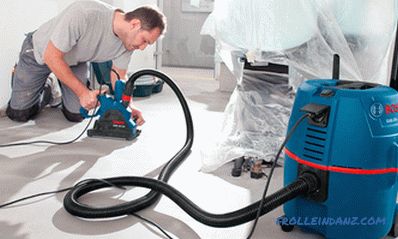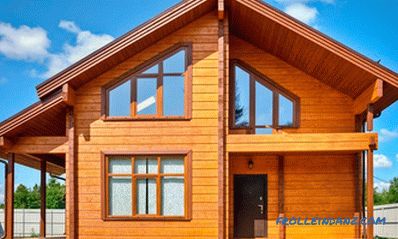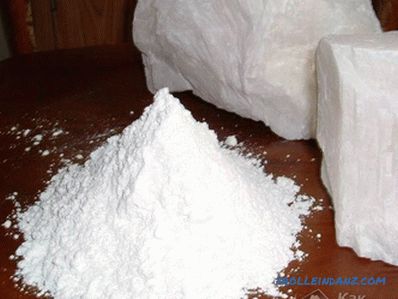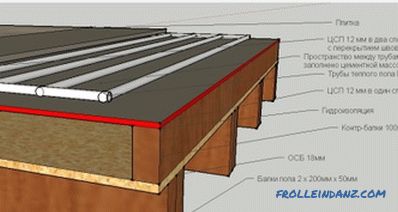Armopoyas is called a reinforced concrete structure, which is designed to strengthen the walls of a house. This is necessary to protect the walls from the stresses caused by external / internal factors. Exposure to wind is external, slope / hilly, floating ground, and earthquake seismic activity. The list of internal factors include all household building fixtures used in the interior decoration of the house. If it is wrong to make an armopoyas, then because of these phenomena, the walls simply crack, and even worse, they will disperse. In view of this, it is very important to be aware of how to make armopoyas. On the types, purpose and method of installing arm-belt and will be discussed in this article.
Views
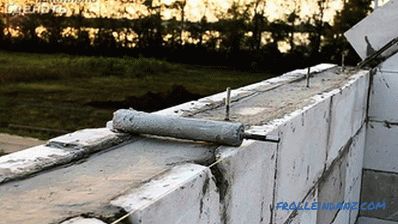
There are 4 types of armored belt:
- grillage;
- ground;
- interfloor;
- under the power plate.
Tools and materials
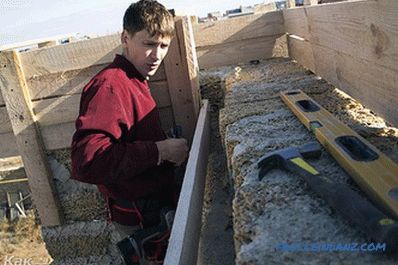
Before starting work, prepare tools / materials:
- Armature.
- Cement.
- Sand.
- Crushed stone.
- Wire for rebar tying.
- Boards.
- Self-tapping screws.
- Brick.
- Spade.
- Concrete Mixer.
- Breaking / crowbar.
- Welding machine.
In order for all the work you have done to be done with high quality, we invite you to familiarize yourself with the technology of making the grill / frame and formwork.
Production of reinforcing mesh / frame
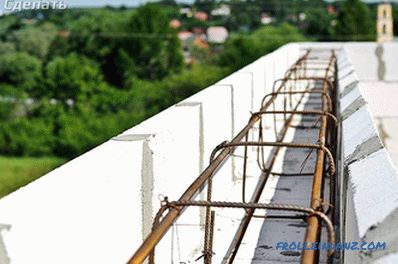
In order for the armored belt to be of high quality and, accordingly, the house to be reliable, you need to know how to make an armature / frame correctly. The connection of the bars of the reinforcement between them is carried out by knitting wire, and not by the welding seam. This is due to the fact that when welding, the space near the weld being made is overheated, which leads to a weakening of the reinforcement strength. But without welding seams in the manufacture of the grid is not enough. The middle and ends of the frame are welded, the rest of the connecting nodes are connected.
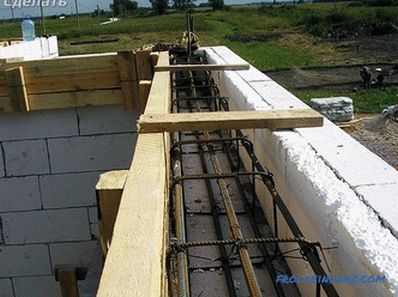 Layed frame in armored belt
Layed frame in armored belt
The bars are fastened to fix the reinforcement in the desired position when cast with concrete. For these purposes, a thin wire is used, the strength of the mesh / frame does not depend on it.
Only ribbed rods are used to make armored belt. Concrete clings to the edges, which contributes to an increase in the bearing capacity of the structure. Such a belt can work in tension.
To make the framework, take 2 cores 12 mm thick and 6 m long, while for transverse reinforcement you will need bars of 10 mm thickness. Along the center and edges of the transverse reinforcement should be welded. The rest of the rods just knit. After making two grids, hang them so that a gap is formed. Cook them from the edges and in the center. Thus, you get a frame. For the manufacture of the belt, the frames do not need welding. They are overlapped by 0.2-0.3 m.
Formwork
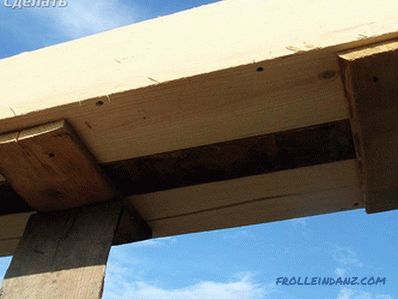
Installation and fixing of formwork is carried out by several methods. To install wooden shields, it is necessary to pass an anchor through them, to mount plugs on them using electric welding. The purpose of these actions is to fix the formwork so that under the weight of concrete it is not squeezed out.
For fixing the formwork when pouring interfloor armopoyasa more often a simpler method is used. At the bottom of the shield, fasten a screw with a diameter of 6 mm and a length of 10 cm. The distance between them is 0.7 m. So, attach the wooden shield to the wall, drill a hole through it, insert a fungus into it and drive a screw.
The hole in the shield should be a little more than 6 mm in diameter. This is necessary in order to freely install the fungus.
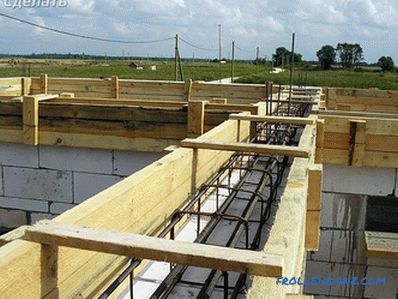 Wooden formwork
Wooden formwork
The upper part of the formwork is also fixed by quick installation. But in this case it is necessary to screw the screw, but not a screw. So, make a hole in the brick masonry. Then hammer the armature into it. If the brick is solid, then the situation is simpler - just drive the nail / reinforcement into the vertical joint. Self-tapping screw and fittings tie a wire. The distance between fasteners is 1-1.2 m. Such fastening is able to withstand the upcoming loads.
After the armored belt hardens, the formwork can be removed using a crowbar / nail puller. In the warm season, the concrete sets in a day. In this case, the dismantling of the formwork can be carried out the next day. In the cold season, this procedure is carried out after a few days.
Rover
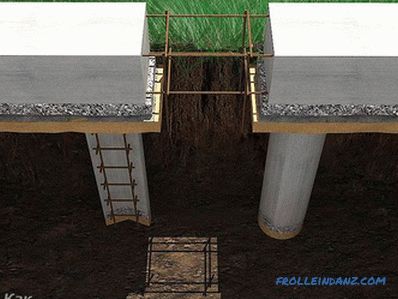
Initially, determine the depth of the foundation. This parameter depends on the type of soil, the depth of its freezing, as well as the depth of groundwater. Then you should dig a trench around the perimeter of the future home. This can be done manually, which is long and tedious or with the help of an excavator, which is quick and efficient, but entails additional costs.
After the special equipment, the bottom and walls of the trench should be leveled to solid ground.The surface should be as solid and smooth as possible.
Now we need to form a sand pillow, the height of which should be 50-100 mm. If necessary, backfilling sand more than 100 mm, it must be mixed with rubble. This event may be needed to level the bottom of the trench. Another way to level the bottom - pouring concrete.
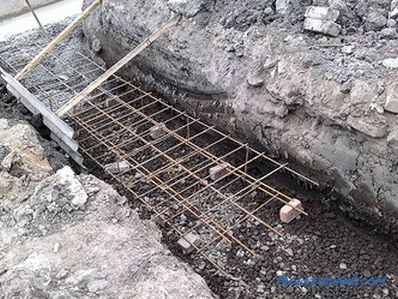 Making the framework for the grillage
Making the framework for the grillage
After filling the sand cushion, it must be compacted. To cope with the task faster, sand water.
Then the reinforcement should be laid. In the course of construction in normal conditions it is necessary to use reinforcement from 4-5 wires, the diameter of each rod should be 10-12 mm. It is important that when pouring the grillage for the foundation, the reinforcement does not touch the base. It should be sunk in concrete. Thus, the metal will be protected from corrosion. To achieve this, the reinforcement mesh should be raised above the sand pillow, laying half of the brick under it.
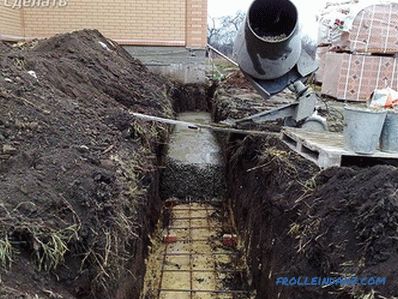 Rost foundation strip foundation
Rost foundation strip foundation
If you build a house on heaving soil or where there is a high level of ground waters, the grillage should be made more durable. To do this, instead of the reinforcing mesh, you should use the reinforcement cage. He imagines 2 grids consisting of 4 strands with a diameter of 12 mm. They should be laid below and above the armored belt. Instead of a sand cushion, granulated slag is used as a base Its advantage over sand is that over time granulated slag turns into concrete.
For the manufacture of the net, we use knitting wire, not welding.
For grillage, use concrete M200. To match the fill height to the specified value, install a beacon in the trench - a metal peg equal to the height of the grillage in length. He will serve as your guide.
Plinth armored belt
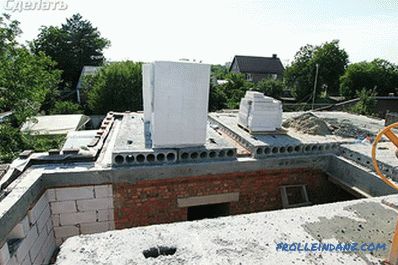
Before building walls on the foundation, you should pour the plinth armored belt. It must be poured around the perimeter of the building along the outer walls, but this cannot be done along the inner bearing walls. The basement armopoyas serves as an additional reinforcement of the structure. If you quality cast grillage, the base belt can be made less durable. Armopoyas height - 20-40 cm, concrete M200 and above is used. The thickness of double-core reinforcing rods - 10-12 mm. Laying reinforcement is carried out in a single layer.
If you need to reinforce the base belt, use reinforcement of greater thickness or install more wires. Another option is to lay the armature in 2 layers.
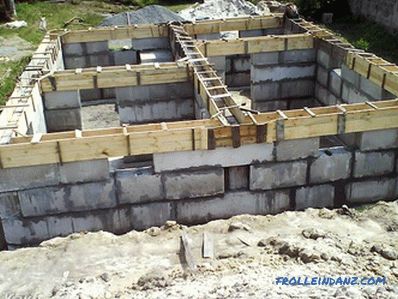 Formwork for the basement armored belt
Formwork for the basement armored belt
The thickness of the basement and exterior wall is the same. It ranges from 510 to 610 mm. In the implementation of pouring basement armored belt, you can do without the formwork, replacing it with brickwork. For this, it is necessary to make laying on a half brick from both sides of the wall. You will be able to fill the resulting void with concrete, having previously placed reinforcement in it.
In the absence of a grillage, the basement arm-belt is useless. Some craftsmen, deciding to save on the grillage, reinforce the base belt, while using reinforcement of larger diameter, which allegedly improves the carrying capacity of the house. In fact, such a decision is unwise.
The rostver is the foundation of the house, and the basement belt is the addition or strengthening of the bearing capacity of the armored belt for the foundation. The joint work of the grillage and the basement belt serves as a guarantee of a reliable foundation even on heaving soils and with a high level of ground water.
Interfloor
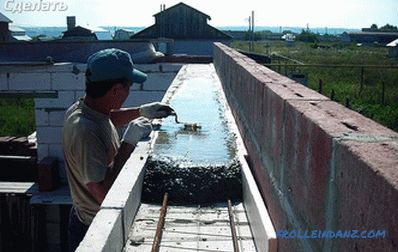
Armored reinforcement should also be made between the wall and the floor slabs. It is poured along the outer walls with a height of 0.2 to 0.4 m. Interstate armored belt allows you to save on door / window lintels. They can be made small and with a minimum of reinforcement. Thus, the load on the structure will be evenly distributed.
If the armopoyas are installed on the walls of a material that does not accept the load, then the load from the floor slabs will be distributed evenly along the entire length of the walls, which will have a beneficial effect on their strength characteristics.
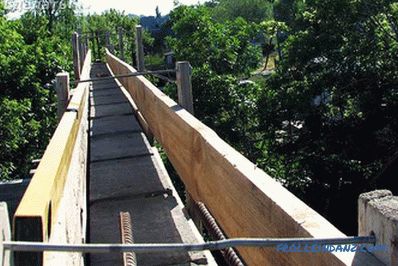 Formwork for the interfloor armored belt
Formwork for the interfloor armored belt
10-12 mm in 2 cores. If the wall thickness varies between 510-610 mm, then double-sided brickwork can be used as a formwork, as well as for the base belt. But at the same time for the internal masonry should be applied zabutovochny brick, and for the outer face. In this case, the armored belt will have a width equal to 260 mm. With a smaller wall thickness, the backing brick should be laid on the edge, or wooden formwork should be used instead, and the front brick should be laid on the outside as in the previous case.
Under the mauerlat
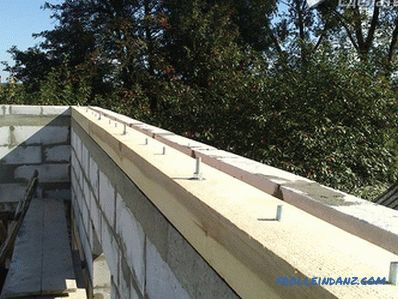
It is possible to pour the armature under the mauerlat only after the curing of the adhesive / mortar for masonry walls. The technology on which the armored belt is put on aerated concrete is different with formwork, but we'll talk about this a little later. The manufacture of wooden formwork is carried out according to the scheme already familiar to you. Concrete is prepared according to the following formula: 2.8 parts of sand for 1 part of cement and 4.8 parts of crushed stone. Thus, you get concrete M400.
After pouring, eliminate residual air bubbles in the mass. To perform these tasks, use a building vibrator or poke the fluid mass with a rod.
Fastening the Mauerlat

With a monolithic device of the armored belt, you should observe the rules for fastening the Mauerlat. During the installation of the frame from the reinforcement it is necessary to withdraw from it the vertical segments to the height determined in the project. The bars of the reinforcement should rise above the armored belt by a thickness of + 4 cm. In the bar it is necessary to make through holes equal to the diameter of the reinforcement, and the ends should be threaded. So, you will get a reliable mount that will give you the opportunity to carry out high-quality installation of the roof of any configuration.
Arm-belt for aerated concrete
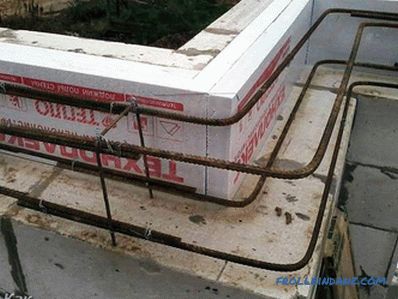
Aerated concrete is an alternative to bricks, which has high thermal insulation qualities along with low cost. Aerated concrete blocks inferior brick strength. If it is not necessary to pour concrete on the brick walls when installing the armored belt, as the reinforcement is laid in the process of laying, then things are different with aerated concrete. How to make an armored belt on wooden formwork has already been discussed above, so in this section we will look at how to make a reinforced belt from U-shaped aerated concrete blocks D500. Although it should be noted immediately that this technology is more expensive.
In this case, everything is extremely simple. Install the blocks on the wall in the usual manner. Then reinforce the central part of them, and then fill with concrete. Thus, the walls of your home will be more durable and reliable.
If you have any questions on the topic, then ask them to a specialist working on the site. If necessary, you can consult about pouring armored belt with our expert. Have a personal experience? Share it with us and our readers, write comments on the article.
Video
You can find out how to make armies for a house of aerated concrete from the video:
